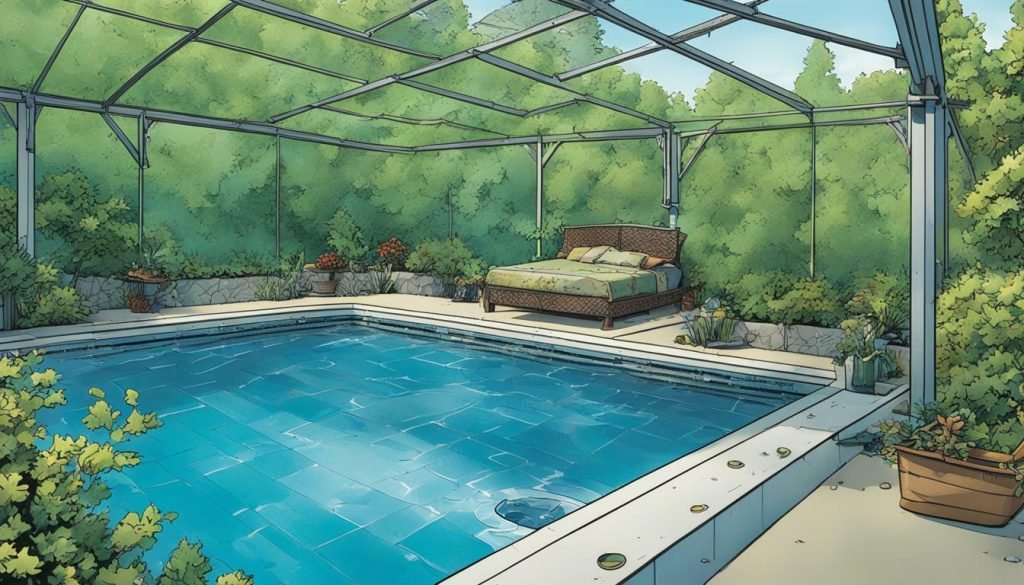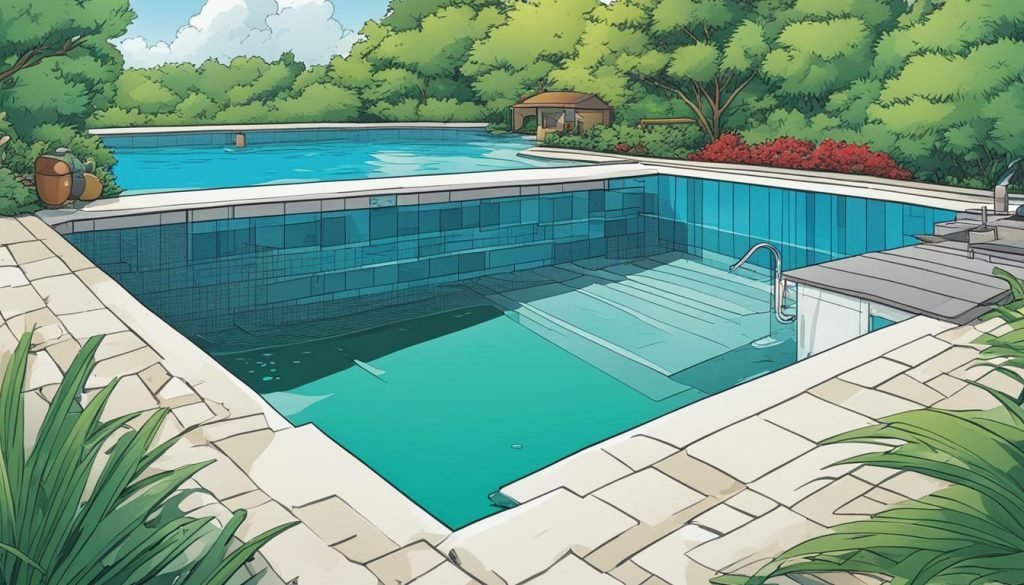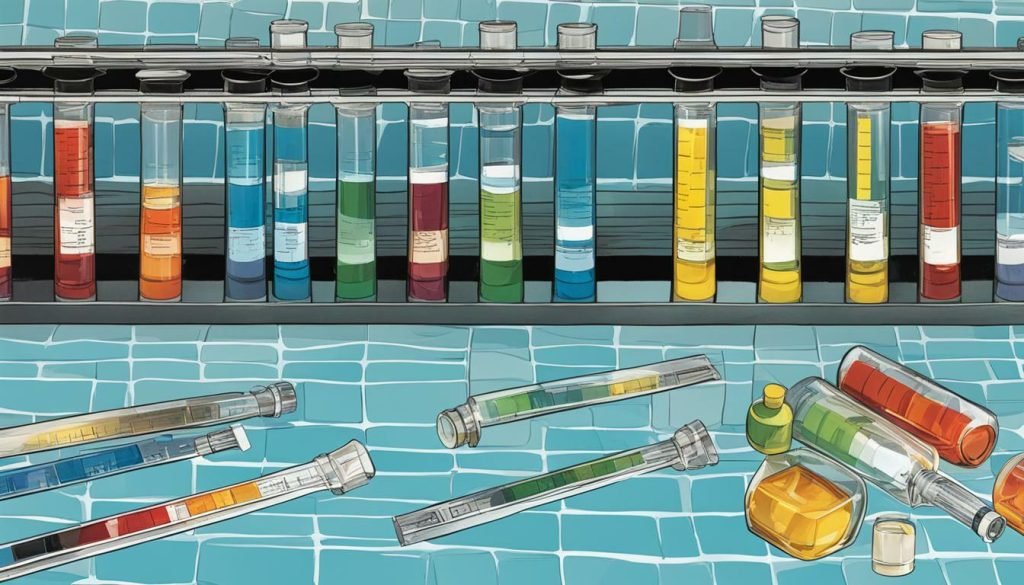Maintaining the correct chemical balance in a swimming pool is crucial for crystal-clear and sparkling water. The three main types of inground swimming pools are fiberglass, vinyl liner, and concrete, with fiberglass pools being the easiest to maintain due to their nonporous surfaces. Fiberglass pools have the lowest short-term and long-term maintenance costs compared to vinyl and concrete pools.
It’s important to test the water regularly for chlorine, pH levels, total alkalinity, total dissolved solids (TDS), and calcium hardness. During the peak season, chlorine and pH levels should be tested two to three times a week, while other tests should be done at least once a month.
Balancing the water’s chemistry involves maintaining the ideal levels of pH, total alkalinity, calcium hardness, temperature, and TDS. Proper water filtration and sanitization are essential for swimmer comfort and safety, and maintaining the right balance helps prevent metal corrosion and pool surface scaling.
Proper equipment selection and installation are also important for efficient pool maintenance. Periodically getting the water professionally tested can help ensure its balance.
Key Takeaways:
- Maintaining chemical balance in a swimming pool is crucial for crystal-clear and sparkling water.
- Fiberglass pools are the easiest to maintain due to their nonporous surfaces and have the lowest maintenance costs.
- Regular testing is necessary to monitor chlorine, pH levels, total alkalinity, TDS, and calcium hardness.
- Proper water filtration and sanitization are essential for swimmer comfort and safety.
- Cleaning the pool regularly and adding chemicals as needed without over-treating the water is important.
Types of Inground Swimming Pools and their Maintenance Requirements
The three main types of inground swimming pools are fiberglass, vinyl liner, and concrete, with fiberglass pools being the easiest to maintain due to their nonporous surfaces. Fiberglass pools have the lowest short-term and long-term maintenance costs compared to vinyl and concrete pools. Their smooth and durable surface resists algae growth and eliminates the need for frequent scrubbing, saving you time and effort in cleaning. Additionally, the nonporous nature of fiberglass prevents water absorption and reduces the chances of stains and discoloration.
On the other hand, vinyl liner pools require periodic replacement of the liner, which can be a significant cost. The liners are susceptible to tears and punctures, requiring careful handling during pool use and maintenance. Concrete pools, while highly customizable and durable, require regular maintenance to prevent cracks and staining. The porous surface of concrete can also promote algae growth, making it more challenging to keep the water clean and clear.
Regardless of the pool type, regular maintenance is crucial for preserving water quality and extending the lifespan of your pool. Following a routine maintenance schedule that includes cleaning, water testing, and chemical balancing will ensure that your inground swimming pool remains a source of relaxation and enjoyment for years to come.
| Pool Type | Maintenance Advantages |
|---|---|
| Fiberglass | Lowest maintenance costs, nonporous surface resists algae and stains |
| Vinyl Liner | Requires periodic liner replacement, susceptible to tears and punctures |
| Concrete | Highly customizable, but requires regular maintenance to prevent cracks and staining |

Fiberglass Pools: The Easiest to Maintain
Fiberglass pools are undoubtedly the easiest to maintain among the three types of inground swimming pools. Their nonporous surface eliminates the need for frequent scrubbing and drastically reduces the occurrence of algae growth. With less time spent on cleaning and maintenance, you’ll have more time to enjoy your pool. Moreover, the low maintenance costs associated with fiberglass pools make them an attractive option for homeowners looking for hassle-free pool ownership.
Vinyl Liner Pools: Considerations for Maintenance
While vinyl liner pools offer flexibility in design and installation, they require careful maintenance. The vinyl liner is prone to tears and punctures, necessitating cautious handling during activities and regular inspections for any signs of damage. Additionally, periodic replacement of the liner is necessary to maintain the pool’s aesthetics and functionality. It’s essential to follow proper cleaning procedures and use gentle equipment to prevent damage to the liner.
Concrete Pools: Durability with Regular Maintenance
Concrete pools offer durability and customization options, but they require consistent maintenance to keep them in optimal condition. Regular cleaning and scrubbing are necessary to prevent staining and the growth of algae in the porous surface. Cracks and surface imperfections should be promptly addressed to avoid further damage. Taking proactive measures, such as applying sealants and using appropriate chemicals, can help prolong the lifespan of a concrete pool.
By understanding the maintenance requirements of each type of inground swimming pool, you can make an informed decision when choosing the right pool for your needs and lifestyle. Remember, regardless of the pool type, regular maintenance and adherence to a maintenance schedule are key to ensuring a clean, safe, and enjoyable swimming experience.
Regular Testing and Water Chemistry
It’s important to test the water regularly for chlorine, pH levels, total alkalinity, total dissolved solids (TDS), and calcium hardness. By monitoring these factors, you can ensure that your pool maintains its chemical balance, resulting in clean and safe water for swimming.
During the peak season, it is recommended to test chlorine and pH levels two to three times a week, while other tests can be performed at least once a month. Regular testing allows you to detect any imbalances in the water chemistry and take prompt corrective actions.
| Chemical | Ideal Range | Purpose |
|---|---|---|
| Chlorine | 1-3 ppm | Kills bacteria and viruses |
| pH | 7.2-7.8 | Maintains water balance |
| Total Alkalinity | 80-120 ppm | Stabilizes pH levels |
| TDS | Less than 1500 ppm | Prevents scale formation |
| Calcium Hardness | 200-400 ppm | Protects pool surfaces and equipment |
These measurements help you understand the current state of your pool’s water chemistry. If any levels are outside the recommended range, you can adjust them accordingly to restore the proper balance.
By regularly testing and maintaining the correct chemical balance, you can enjoy a pool that not only looks inviting but also ensures the health and safety of those who swim in it.

Maintaining Ideal Chemical Levels
Balancing the water’s chemistry involves maintaining the ideal levels of pH, total alkalinity, calcium hardness, temperature, and TDS. These factors play a vital role in ensuring crystal-clear and sparkling water in your swimming pool. Regular testing is essential to keep these levels in check and maintain a safe and enjoyable swimming environment.
When it comes to pH levels, the ideal range for balanced water is between 7.2 and 7.8. This range ensures that the chlorine in the pool remains active and effective in killing bacteria and viruses. Lower pH levels can cause eye and skin irritation, while higher pH levels can lead to scale formation on pool surfaces.
Total alkalinity helps stabilize pH levels and should be kept between 80 and 150 ppm (parts per million). Adequate alkalinity prevents fluctuations in pH, which can impact water balance and the effectiveness of sanitizers. Insufficient alkalinity can result in pH spikes or drops, leading to a host of water-related issues.
Calcium hardness is another important factor in maintaining ideal chemical levels. The recommended range for calcium hardness is between 200 and 400 ppm. Adequate calcium hardness protects pool surfaces and equipment from damage caused by corrosive or scaling water. High levels can lead to cloudy water and scale formation, while low levels can cause plaster etching and damage to pool surfaces.
| Chemical | Ideal Range |
|---|---|
| pH | 7.2-7.8 |
| Total Alkalinity | 80-150 ppm |
| Calcium Hardness | 200-400 ppm |
| Temperature | Varies based on preferences |
| TDS | Varies based on water source and treatment |
Additionally, maintaining the right temperature and total dissolved solids (TDS) level in your pool is crucial for optimal water balance. Temperature preferences may vary, but a comfortable range for most swimmers is between 78 and 82 degrees Fahrenheit. TDS levels depend on the water source and any treatments applied, so it’s essential to monitor and adjust as necessary.
By regularly testing and adjusting these chemical levels, you can ensure a safe and enjoyable swimming experience for you and your family. Following these guidelines and seeking professional assistance when needed will help maintain the correct chemical balance in your swimming pool, resulting in clean, inviting water throughout the swimming season.

Filtration, Sanitization, and Additional Considerations
Proper water filtration and sanitization are essential for swimmer comfort and safety, and maintaining the right balance helps prevent metal corrosion and pool surface scaling. A well-functioning filtration system removes debris, bacteria, and other contaminants, ensuring that the water remains clean and clear. It is important to regularly clean and backwash the filters to maintain their efficiency and effectiveness.
In addition to filtration, sanitization is crucial to keep the water free from harmful bacteria and viruses. The most commonly used sanitizing agent in swimming pools is chlorine, which effectively kills microorganisms. The two forms of chlorine in pool water are free chlorine and combined chlorine, with free chlorine being the active form that kills bacteria and viruses. Maintaining the proper level of free chlorine ensures that the water remains safe for swimmers.
To achieve optimal pool water quality, it is important to regularly test and adjust the chemical levels. Monitoring the pH level is essential, as it affects the effectiveness of chlorine and the comfort of swimmers. The ideal pH level for balanced water is between 7.2 and 7.8. Total alkalinity helps stabilize pH levels and should be maintained within the recommended range. Calcium hardness, which measures the amount of dissolved calcium in the water, helps protect pool surfaces and equipment. Regularly testing and adjusting the levels of these chemicals will help maintain the desired water balance.
It is also worth considering the use of additional pool chemicals to address specific issues. Cyanuric acid can help stabilize chlorine levels and protect it from degradation due to sunlight. Algaecides can be used to prevent the growth of algae, while clarifiers improve water clarity by removing small particles. Stain and scale removers are useful in preventing and treating unsightly stains caused by metals and mineral buildup. Carefully following the manufacturer’s instructions and consulting with a pool professional can help determine the appropriate use of these chemicals.
To summarize, proper water filtration and sanitization are vital for maintaining a clean and safe swimming pool. Regular testing and adjustment of chemical levels, particularly pH, alkalinity, and calcium hardness, will help achieve optimal water balance. Additional pool chemicals can be used as necessary to address specific issues. By following these guidelines and regularly maintaining the pool, you can ensure that your swimming pool remains a refreshing and enjoyable oasis.

Cleaning and Maintenance Tips
It’s important to regularly clean the pool and skimmer baskets, and to add chemicals as needed without over-treating the water. Cleaning your pool not only ensures hygienic swimming conditions but also prolongs the life of your pool equipment. Here are some essential tips to keep your pool in top shape:
- Skim the pool surface: Use a skimmer net or skimmer basket to remove leaves, debris, and any other floating objects from the pool water. This prevents them from sinking to the bottom and making cleaning more difficult.
- Brush the pool walls and floor: Use a pool brush to scrub the walls and floor of your pool regularly. This helps remove algae, dirt, and other stubborn stains. Pay special attention to corners, steps, and areas with poor water circulation.
- Vacuum the pool: Use a pool vacuum or an automatic pool cleaner to remove dirt and debris from the bottom of the pool. Vacuuming should be done at least once a week to keep the pool water clean and clear.
- Clean the pool filter: The pool filter plays a crucial role in maintaining the water’s clarity. Depending on the type of filter (sand, cartridge, or diatomaceous earth), follow the manufacturer’s instructions to clean or replace the filter media regularly. This ensures optimal filtration and prevents clogging.
- Check and adjust chemical levels: Regularly test the pool water for chlorine, pH levels, alkalinity, and other chemical parameters using a reliable pool water testing kit. Adjust the chemical levels as necessary to maintain optimal balance, which enhances swimmer comfort and prevents water-related issues.
Remember, proper pool maintenance requires consistent effort. By following these cleaning tips, you’ll be able to enjoy a clean, safe, and visually appealing swimming pool all season long.

Equipment Checklist:
| Equipment | Frequency |
|---|---|
| Skimmer net/basket | Daily |
| Pool brush | Weekly |
| Pool vacuum/automatic cleaner | Weekly |
| Pool filter | As per manufacturer’s instructions |
| Pool water testing kit | Weekly |
By keeping a regular cleaning schedule and maintaining the right chemical balance, you can enjoy a pristine and inviting swimming pool throughout the year. Don’t forget to consult with a pool professional for personalized advice based on your specific pool type and usage.
Professional Testing and Conclusion
Periodically getting the water professionally tested can help ensure its balance. Proper pool water balance is crucial for maintaining crystal-clear and sparkling water, ensuring swimmer comfort and safety. Regular testing allows you to monitor and adjust important chemical levels to keep your pool in optimal condition.
Testing your pool water involves monitoring various factors, including chlorine levels, pH levels, total alkalinity, total dissolved solids (TDS), and calcium hardness. During the peak season, testing chlorine and pH levels two to three times a week is recommended, while other tests should be performed at least once a month.
To maintain the ideal chemical balance, you need to ensure the proper levels of pH, total alkalinity, calcium hardness, temperature, and TDS. The pH level should be between 7.2 and 7.8 to keep the water balanced. Total alkalinity helps stabilize pH levels, while calcium hardness protects the pool surfaces and equipment from damage.
In addition to regular testing, it is essential to prioritize proper filtration and sanitization. This helps remove impurities, maintain water clarity, and prevent the growth of harmful bacteria and algae. Ensuring the right balance of chemicals also helps prevent metal corrosion and pool surface scaling.
| Chemical | Ideal Level |
|---|---|
| pH | 7.2-7.8 |
| Total Alkalinity | 80-120 ppm |
| Calcium Hardness | 200-400 ppm |
| Temperature | 78-82°F |
| TDS | 500-1500 ppm |
Regular cleaning and maintenance, including skimming the water’s surface and cleaning skimmer baskets, are essential to keep the pool free of debris and maintain water quality. When adding chemicals, it is important to follow product instructions and avoid over-treating the water, as this can lead to imbalanced chemistry and water problems.
By following these guidelines and periodically getting your pool water professionally tested, you can ensure that your pool maintains the correct chemical balance. This will not only enhance the appearance of your pool but also provide a safe and enjoyable swimming experience for you and your family.

Conclusion
Maintaining the correct chemical balance in a swimming pool involves regular testing, cleaning, and the careful addition of chemicals to ensure the water’s clarity and safety. Crystal-clear and sparkling water is the result of a well-balanced pool, and it all starts with understanding the importance of chemical balance.
There are three main types of inground swimming pools: fiberglass, vinyl liner, and concrete. Fiberglass pools, with their nonporous surfaces, are the easiest to maintain. They have both short-term and long-term maintenance advantages over vinyl and concrete pools, making them a popular choice for pool owners.
Regular testing of the pool water is essential. Chlorine, pH levels, total alkalinity, total dissolved solids (TDS), and calcium hardness should be monitored regularly. During the peak season, chlorine and pH levels should be tested two to three times a week, while other tests should be done at least once a month.
Keeping the water’s chemistry in balance involves maintaining ideal levels of pH, total alkalinity, calcium hardness, temperature, and TDS. Proper water filtration and sanitization are crucial for swimmer comfort and safety. They also help prevent metal corrosion and pool surface scaling. Regular cleaning of the pool and skimmer baskets is necessary, and chemicals should be added as needed without over-treating the water.
Periodic professional water testing can provide additional assurance of the pool’s balance. Expert advice and proper equipment selection are also important for efficient pool maintenance. Overall, by following these guidelines and maintaining the correct chemical balance in your swimming pool, you can ensure crystal-clear and safe water for your enjoyment.
How Does Maintaining the Correct Chemical Balance in a Swimming Pool Affect Water Levels?
Maintaining the correct chemical balance in a swimming pool is crucial for managing pool water levels effectively. Certified professionals use precise measurements to ensure the pH, alkalinity, and sanitizer levels are in check. A balanced pool chemistry prevents water from becoming corrosive or scaling, ultimately protecting the pool’s infrastructure and equipment. By regularly monitoring and adjusting the chemical balance, water levels can be optimized to provide a safe and enjoyable swimming experience.
FAQ
Why is maintaining the correct chemical balance important in a swimming pool?
Maintaining the correct chemical balance in a swimming pool is important for crystal-clear and sparkling water. It helps prevent metal corrosion, pool surface scaling, and ensures swimmer comfort and safety.
What are the three main types of inground swimming pools?
The three main types of inground swimming pools are fiberglass, vinyl liner, and concrete pools. Fiberglass pools are the easiest to maintain due to their nonporous surfaces.
How often should I test the water in my pool?
During the peak season, chlorine and pH levels should be tested two to three times a week. Other tests such as total alkalinity, total dissolved solids (TDS), and calcium hardness should be done at least once a month.
What levels should I maintain for pH, total alkalinity, and calcium hardness?
The ideal pH level for balanced water is between 7.2 and 7.8. Total alkalinity helps stabilize pH levels and should ideally be maintained between 80 and 120 parts per million (ppm). Calcium hardness should be kept between 150 and 250 ppm to protect pool surfaces and equipment.
How can I ensure proper filtration and sanitization in my pool?
Proper water filtration is essential for removing debris and keeping the water clean. Regularly cleaning the pool and skimmer baskets will help maintain efficient filtration. Sanitization can be achieved using chlorine, which comes in two forms: free chlorine and combined chlorine. Free chlorine is the active form that kills bacteria and viruses in the water.
How do I clean my pool and skimmer baskets?
Cleaning the pool involves brushing the walls and floor, skimming the surface for debris, and vacuuming the pool. Skimmer baskets should be emptied regularly to ensure proper water flow.
Can I add too many chemicals to my pool?
Yes, adding excessive chemicals can lead to imbalanced water and may cause issues. It’s important to follow the recommended dosage instructions when adding chemicals and avoid over-treating the water.
Should I get my pool water tested by a professional?
Periodically getting your pool water professionally tested can help ensure its balance and identify any potential issues that may require attention.

